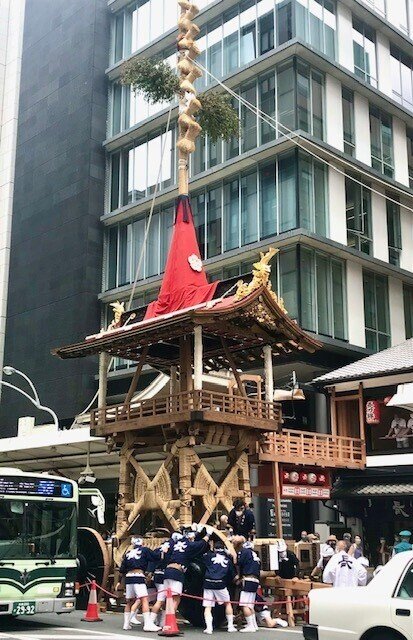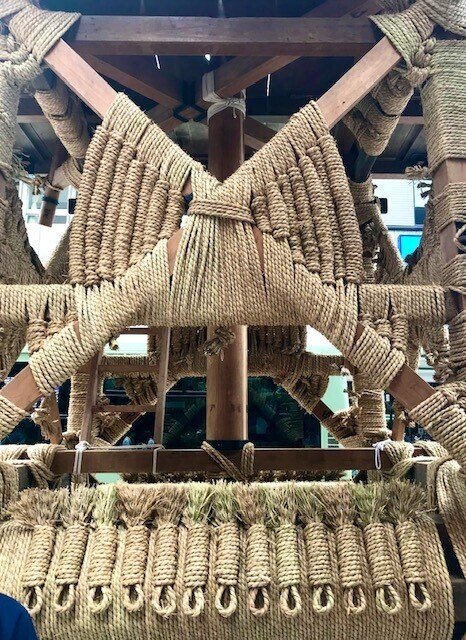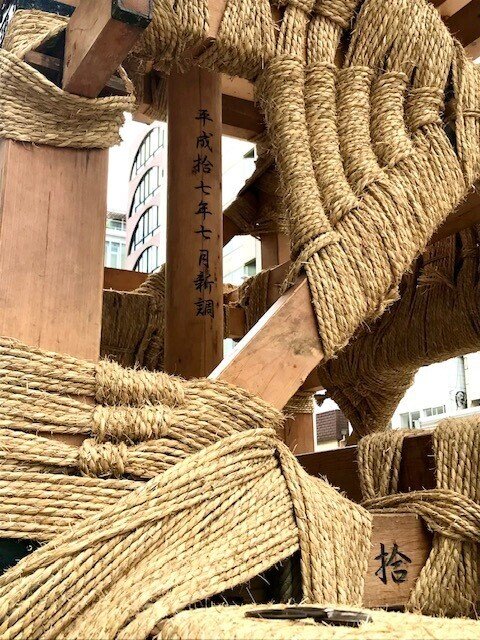
祇園祭のもう一つの祭典。山鉾巡行を支える「作事三方」の人と技 【祇園祭シリーズ〈縄がらみ〉】 Another festival of Gion Matsuri. People and techniques of "Sakuji-sanpo" who support the Yamahoko cruise [Gion Matsuri series ]
昨日、祇園祭を見に行ってきた。
通常なら7月17日は、前祭りの山鉾巡行の日。しかしながら、新型コロナウィルスで昨年、今年は中止。その代わりに山鉾町の代表者が徒歩で八坂神社の四条御旅所を目指し「拝礼行列」を行った。
I went to see Gion Matsuri yesterday. Normally, July 17th is the day of the float parade of the previous festival. However, it was canceled last year and this year due to the new coronavirus. Instead, a representative of the float town held a "worship procession" on foot toward the Shijo Otabisho of Yasaka Shrine.
通常17日は、山鉾巡行のあとすぐに山鉾は解体され後祭りにつなげていくのだが、今年はこの日、車輪とタペストリーが外され、翌日の18日に一斉に山鉾が解体されていく。その山鉾の骨組みがむき出しになり、山鉾を支える祇園祭ならではの伝統技術が見えてきた。
コロナ禍において祇園祭は中止と言われた中で、山鉾を建てるのは組み立て技術の伝承を欠かさず続けることがもっとも大きな理由、と関係者は言う。
Normally, on the 17th, the floats are dismantled immediately after the float cruise and connected to the festival afterwards, but this year the wheels and tapestries are removed, and the floats are dismantled all at once on the 18th the next day. The skeleton of the floats has been exposed, and the traditional techniques unique to the Gion Festival that support the floats have become apparent. The Gion Festival was said to be canceled in the Corona sword, but the main reason for building the floats is to continue to hand down the assembly techniques, officials said.

山鉾建ての作り方を大まかにいうと、柱を重ねそれに縄をかけ締めていく縄がらみ作業を「手伝い方」といい、天井や床などを組み立てる大工仕事を「大工方」という。そして、山鉾を支える車輪を担当するのが「車方」。大きくこの3つに分かれ「作事三方」という。
山鉾建ては3日間かけて組み建てられるが、その前半が「手伝い方」の作業である。
三方共に巡行を支える、専門技能を持った技術者集団がいる。
Roughly speaking, the method of making a float is called "helping", and the carpentry work of assembling ceilings and floors is called "carpentry". And the " wheels-worker" is in charge of the wheels that support the floats. It is roughly divided into these three and is called "Sakuji Sanpo". The floats are built over three days, but the first half is the work of "helping". There is a group of engineers with specialized skills who support the cruise on all three sides.
今回、紹介するのが縄がらみ。蝶と称される縄がらみは、10t以上ある長刀鉾には両側に7本ずつあり、正面の結び方を特に「雄蝶」(写真)という。強度だけではなく見栄えも大事なことのようである。山鉾建てでは吉例として奇数という決まりがあり、5本の山鉾もあるが、どの山鉾でも毎年寸分違わぬ形に組みあがる。
This time, I would like to introduce a rope of Nawagarami. There are seven ropes on each side of a long sword that weighs more than 10 tons, and the way to tie the front is called "male butterfly" (photo). It seems that not only strength but also appearance is important. There is a rule that the number of floats is odd in the float construction, and there are five floats, but every float is assembled in the same shape every year.

雄蝶をモチーフにした縄がらみ7本締め
写真の下方の縄がらみは海老と称される部分。構造上の必然性はなく、装飾としての意味合いが強いようである。縄がらみが作れるようになるのに少なくとも10年はかかるようだ。
伝統文化を育む歴史背景や神事に加え、それを司る山鉾や神輿など、そしてそれらを作り操る方法や人があってこその文化継承である。
今回、祇園祭で見た “人の力” “匠の技”が、もう一つの祇園祭の祭典のように思えた。
The rope at the bottom of the photo is the part called shrimp. There is no structural necessity, and it seems to have a strong meaning as a decoration. It seems that it will take at least 10 years to be able to make rope ties. In addition to the historical background and Shinto rituals that nurture traditional culture, the floats and portable shrines that govern them, as well as the methods and people who create and manipulate them, are the only way to inherit the culture. The "human power" and "craftsmanship" that I saw at the Gion Festival seemed like another Gion Festival.

リポート & 写真 / 渡邉雄二 Reported & Photos by Yuji Watanbe
よろしければサポートお願いします。日本の伝統文化に関心を寄せています。若いころに文化圏の異なる地域の方たちとの交流で日本のことをあまりにも知らなかったことに気づかされ、それがきっかけで広く浅く学んでいます。拙いレポートですが、お目に留めていただければ幸です。
